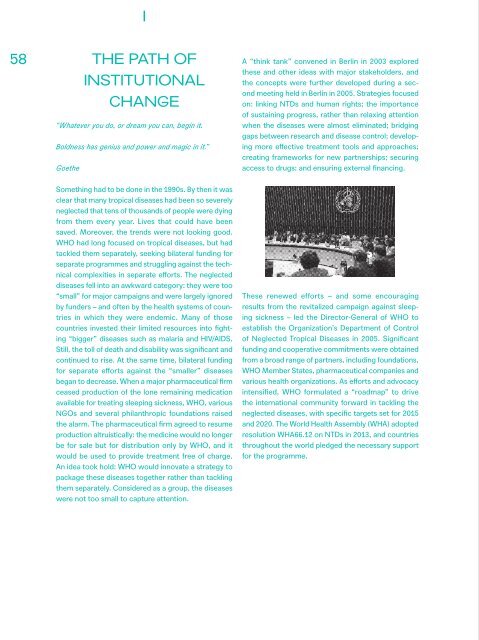Create successful ePaper yourself
Turn your PDF publications into a flip-book with our unique Google optimized e-Paper software.
I<br />
58<br />
<strong>THE</strong> PATH OF<br />
INSTITUTIONAL<br />
CHANGE<br />
“Whatever you do, or dream you can, begin it.<br />
Boldness has genius and power and magic in it.”<br />
Goethe<br />
A “think tank” convened in Berlin in 2003 explored<br />
these and other ideas with major stakeholders, and<br />
the concepts were further developed during a second<br />
meeting held in Berlin in 2005. Strategies focused<br />
on: linking NTDs and human rights; the importance<br />
of sustaining progress, rather than relaxing attention<br />
when the diseases were almost eliminated; bridging<br />
gaps between research and disease control; developing<br />
more effective treatment tools and approaches;<br />
creating frameworks for new partnerships; securing<br />
access to drugs; and ensuring external financing.<br />
Something had to be done in the 1990s. By then it was<br />
clear that many tropical diseases had been so severely<br />
neglected that tens of thousands of people were dying<br />
from them every year. Lives that could have been<br />
saved. Moreover, the trends were not looking good.<br />
WHO had long focused on tropical diseases, but had<br />
tackled them separately, seeking bilateral funding for<br />
separate programmes and struggling against the technical<br />
complexities in separate efforts. The neglected<br />
diseases fell into an awkward category: they were too<br />
“small” for major campaigns and were largely ignored<br />
by funders – and often by the health systems of countries<br />
in which they were endemic. Many of those<br />
countries invested their limited resources into fighting<br />
“bigger” diseases such as malaria and HIV/AIDS.<br />
Still, the toll of death and disability was significant and<br />
continued to rise. At the same time, bilateral funding<br />
for separate efforts against the “smaller” diseases<br />
began to decrease. When a major pharmaceutical firm<br />
ceased production of the lone remaining medication<br />
available for treating sleeping sickness, WHO, various<br />
NGOs and several philanthropic foundations raised<br />
the alarm. The pharmaceutical firm agreed to resume<br />
production altruistically: the medicine would no longer<br />
be for sale but for distribution only by WHO, and it<br />
would be used to provide treatment free of charge.<br />
An idea took hold: WHO would innovate a strategy to<br />
package these diseases together rather than tackling<br />
them separately. Considered as a group, the diseases<br />
were not too small to capture attention.<br />
These renewed efforts – and some encouraging<br />
results from the revitalized campaign against sleeping<br />
sickness – led the Director-General of WHO to<br />
establish the Organization’s Department of Control<br />
of Neglected Tropical Diseases in 2005. Significant<br />
funding and cooperative commitments were obtained<br />
from a broad range of partners, including foundations,<br />
WHO Member States, pharmaceutical companies and<br />
various health organizations. As efforts and advocacy<br />
intensified, WHO formulated a “roadmap” to drive<br />
the international community forward in tackling the<br />
neglected diseases, with specific targets set for 2015<br />
and 2020. The World Health Assembly (WHA) adopted<br />
resolution WHA66.12 on NTDs in 2013, and countries<br />
throughout the world pledged the necessary support<br />
for the programme.


